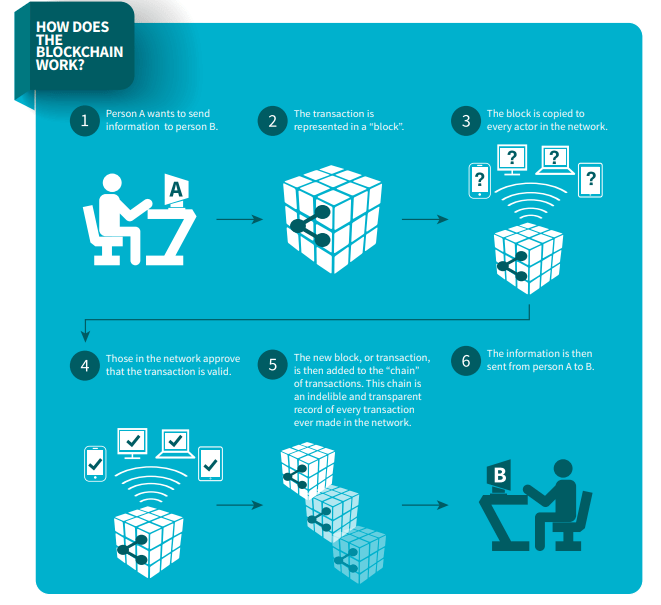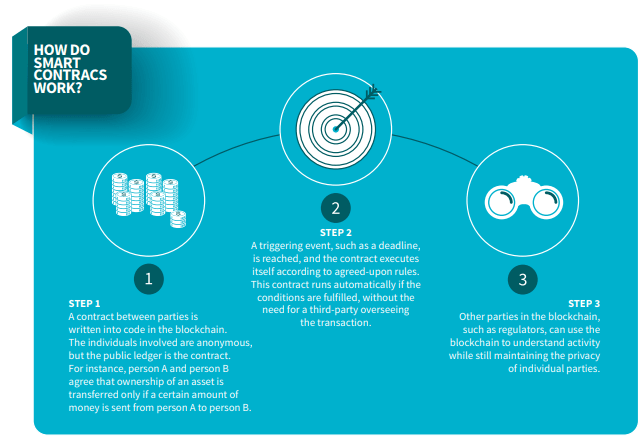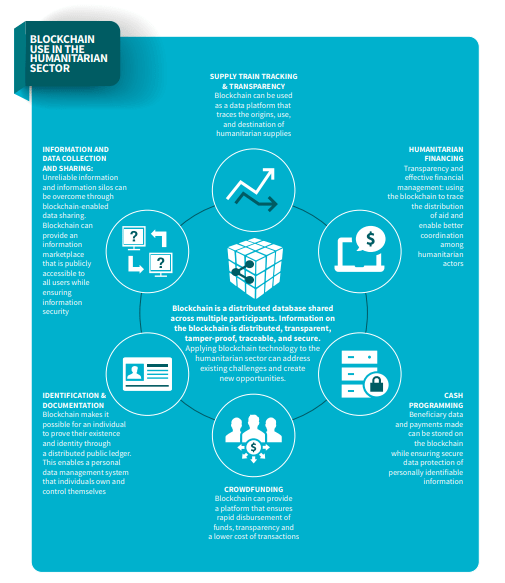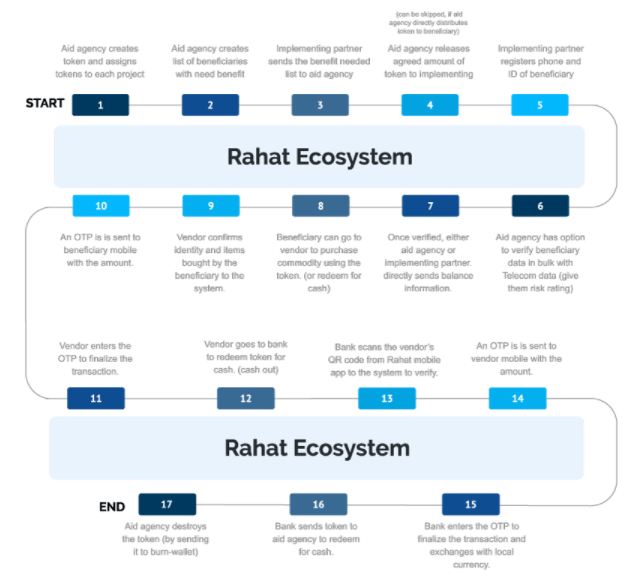From protected data sharing, providing accessible and verifiable identity documents to individuals, creating dynamic supply chains, donor financing, cash-based programming to crowdfunding and microfinancing, the blockchain technology can bring about revolution in the humanitarian aid sector and the aid distribution sector to be specific. The blockchain technology has adjusted to make numerous open and private blockchains. Open blockchains being a stage to help savvy and smart contracts-that are the protocols of the computers that not just encourage, confirm and authorize the presentation or arrangement of the contracts yet additionally they are mechanized and self-executing implying that nobody controls the shrewd arrangements like Ethereum stage. The private blockchain has its own arrangement of highlights and features as chosen by its actors and constrained by a group of limited actors.

How does the blockchain work? (Image Source: https://bit.ly/2PX4VSJ )

Smart Contracts (Image Source: https://bit.ly/2PX4VSJ)
As the advancement of blockchain technology marks its applicability in various sectors ranging from healthcare, agriculture, banking and finance, entertainment, healthcare, retail to real estate, charity and donation, aid distribution, the Blockchain evangelists contend that administration establishments like governments and banks could manage vulnerabilities around trust. Blockchain could deliver those organizations outdated by empowering people to trade securely and transparently with its technology alone, without the requirement for focal outsiders and central third parties as it results in the lower transaction and overhead costs in the long run.
The utility of Blockchain technology for the development and humanitarian sectors is most likely not to be confined to its original idea of cryptocurrency but shows the most promise in the application of the technological advantages, by ultimately automatizing many logistical processes, and informational infrastructures, such as the management of digital identity and so-called smart contracts. With the help of blockchain, smart contracts can be automated to help the transactions be faster and the beneficiaries will receive the aid soonest.
In the humanitarian sector, there are ample fields in which blockchain technology can be used. Applying blockchain technology to the humanitarian sector can address existing challenges such as inadequate infrastructure of the internet, limited scalability, technical barriers in understanding blockchain technology, and the social and regulatory frameworks including applicable privacy norms by adding value in various ways in the humanitarian aid sector. Blockchain innovation can possibly give significant advantages in the humanitarian sector with protected data sharing, supply chain, donor financing, cash program, and crowdfunding. By providing a decentralized, verifiable source of data, blockchain technology can enable a more transparent, efficient form of information and data management.

Blockchain in Humanitarian Sector (Image Source: https://bit.ly/2PX4VSJ)
One of the promising uses of blockchain has been in the distribution of aid relief to people as part of emergency relief response also known as voucher distribution. When disasters such as earthquakes and landslides strike, it becomes much harder to deliver aid in a quick and inefficient way as there are several factors associated with it. Blockchain processes in the humanitarian aid distribution with the assistance of its four actors: first being the aid agency. The aid agency signs a contract with the second actor that is the bank or financial institution. The bank or the financial institution will at that point enlist the data through the individual identity cards or through the Know Your Customer (KYC) Form. As the aid agency sends the token to the beneficiaries, the beneficiaries at that point connect with the third actors- the vendors. The vendor will then be liable to not only receive but also accept the token as they are bound under contract, code the OTP or other tokens and then receive the token from the beneficiaries in exchange for the cash or goods. Once done, the vendor goes to the bank and collects the money that is receivable.

Aid Distribution Process (Image Source)
In Nepal, Oxfam and Sikka have been playing a major role in aid and relief distribution with the use of electronic technology and blockchain technology respectively.
Oxfam’s humanitarian program works for disaster preparedness and response during a disaster. Oxfam in Nepal has experience of working in emergencies such as Koshi Floods of 2008, Banke floods of 2014 and the devastating earthquake of April 2015, and the 2017 floods. Through the current humanitarian program, Nepal Earthquake Recovery Programme, Oxfam responded to the earthquake-affected population in seven of the 14 most affected districts: Gorkha, Nuwakot, Dhading, Sindhupalchowk, Kathmandu, Lalitpur, and Bhaktapur. In the last three years, Oxfam in Nepal has reached out to more than 600,000 people who were affected by the earthquakes of 2015. In collaboration with local partners, Oxfam also distributed hand hygiene products and Personal Protective Equipment at the municipality level to further support health posts, isolation centers, quarantine centers and security agencies to help fight with the novel Coronavirus- COVID 19.
Sikka is an application subsidized by and worked in-house at World Vision’s Nepal Innovation Lab in Kathmandu, Nepal. The name “Sikka” signifies “coin” in Nepali, which alludes to its utilization of an Ethereum token agreement to deal with the creation, dissemination, and approval of all exchanges inside humanitarian aid programming. The framework was contrived to permit clients to send and receive tokens by interfacing with the Ethereum main network by means of SMS, where the client’s wallet is associated with their mobile number. Sikka distributed 583,000 Nepali Rupees (roughly $5,500 USD) to 73 recipients; and the expenses for Ether and SMS added up to under $0.50 USD per recipient while the post pilot analysis of time and costs clearly demonstrated a decrease of operational expenses by over 78% contrasted with ordinary conveyance process. Sikka additionally helped chop down dispersion time from an entire day (considering time it would take for recipients to make a beeline for the banks in area headquarters, get installments and head back contrasted with the time it took for them to arrive at the neighborhood monetary agreeable for the equivalent) to a couple of hours.
Contributing to the humanitarian aid distribution, eSatya- a blockchain initiative by Rumsan Associates, has recently completed two Rahat pilot projects in the Naxal and Kalanki area of Kathmandu. Rahat, which means relief in the Nepali language, is a blockchain-based, digital Cash and Voucher Assistance (CVA) management system. It uses mobile-based blockchain tokens for emergency response and recovery programs for humanitarian agencies. Rahat manages and monitors the flow of transactions in cash distribution projects, maintaining end-to-end transparency among various stakeholders to ensure faster fund transfer to the beneficiaries with providing real-time visibility into the flow of the funds. Rahat has successfully distributed goods that are worth Rs. 1 Lakh thirty thousand through 4 vendors for the 40 beneficiaries’ families. The aid was distributed to the families that were finally affected during the COVID-19 pandemic during the lockdown which was a package that consisted of rice, flour, oil, lentils, beans, sugar, salt, detergent soaps, handwash, dishwashing soap, etc. The beneficiaries and the vendor responded that the system is easy to operate and the beneficiaries further stated that they are more than happy to have received the relief materials and they were finally able to fulfill their basic needs after a long time.

Rahat Ecosystem (Image Source: https://bit.ly/2E9qrBs)
With the assistance of Blockchain technology, distributing aid can be much simpler, easier, and efficient. This could help distribute aid from across the world to anyone in need without a hassle and the misuse of funds. With the real time monitoring, not only do the beneficiaries get the relief on time but also it assures the donors that the aid is being provided to the needy ones.
References:



